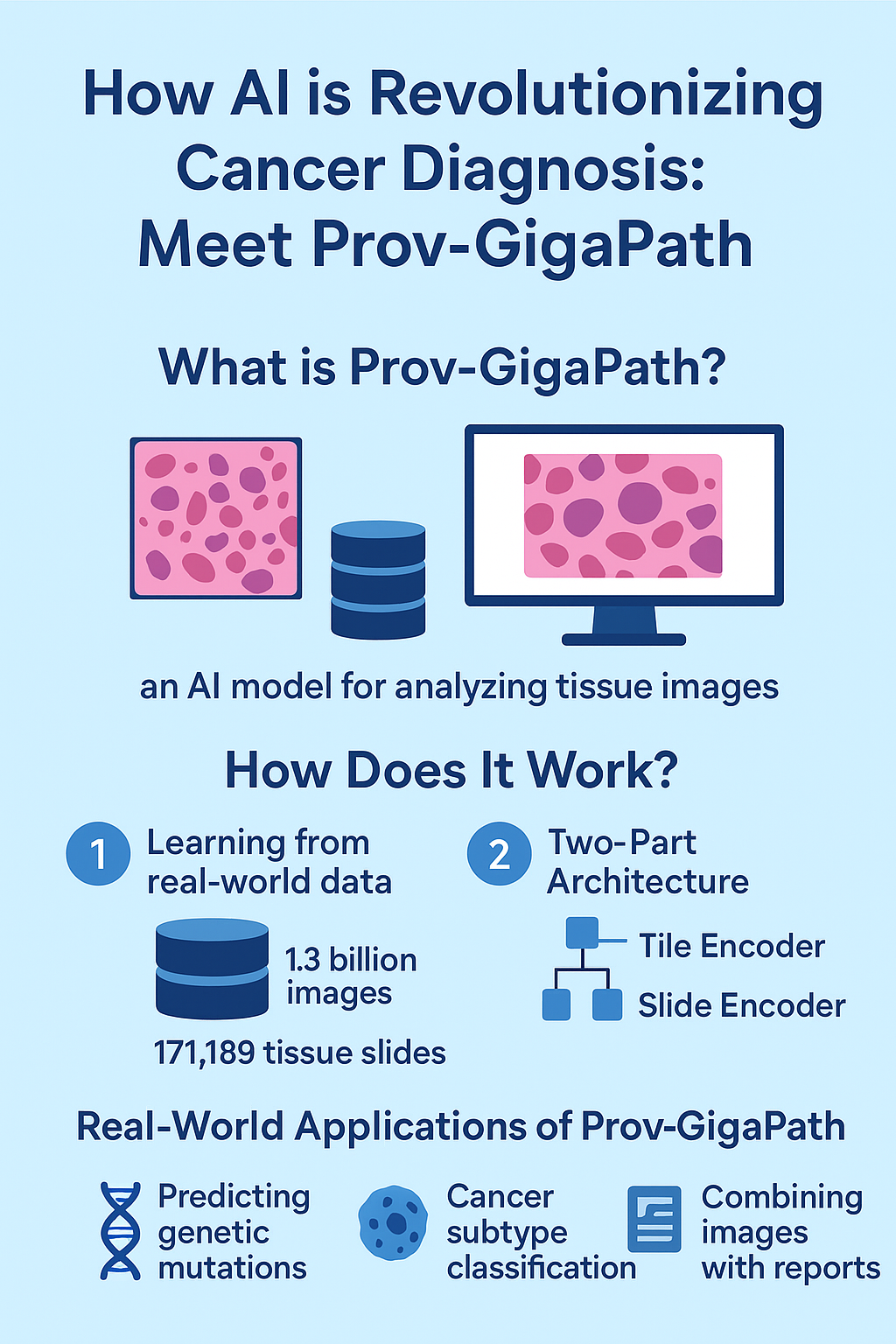Discover how Prov-GigaPath AI revolutionizes cancer diagnosis with 90.8% accuracy, analyzing entire tissue slides to predict mutations and personalize treatment for better patient outcomes.
Introduction
Picture this: you’re a pathologist staring at a tissue slide containing over 100,000 microscopic regions, each potentially harboring the cellular secrets that could save or doom your patient. Traditional analysis would take hours, maybe days, and even then, you might miss that one critical anomaly hidden in the biological haystack. Now imagine an AI that can process this entire slide in minutes, achieving 90.8% diagnostic accuracy while you grab your morning coffee.
This isn’t science fiction—it’s Prov-GigaPath, and it’s about to fundamentally reshape how we diagnose cancer. But here’s the uncomfortable truth most medical AI coverage won’t tell you: this breakthrough forces us to confront some hard questions about the future of pathology itself.
What is Prov-GigaPath?
Prov-GigaPath is an AI model developed by Providence Health System, Microsoft Research, and the University of Washington. Unlike traditional models that analyze tissue images in small patches, Prov-GigaPath looks at the whole slide at once, giving a global and precise understanding of cellular patterns.Tissue images can contain billions of pixels.
The Uncomfortable Reality: Why Traditional Pathology Is Hitting Its Limits
Let’s be brutally honest about something the medical establishment rarely discusses openly: pathology, despite being the cornerstone of cancer diagnosis, is inherently limited by human cognitive capacity. Analyzing each pixel individually would be like trying to read a book by looking at every single letter without understanding the words. Prov-GigaPath sees the big picture, allowing it to detect subtle and complex patterns crucial for accurate cancer diagnosis.
The numbers are staggering: a typical tissue slide contains billions of pixels arranged in patterns so complex that even the most experienced pathologist can only process a fraction of the available information. We’ve been accepting diagnostic uncertainty as an inevitable cost of doing business, but Prov-GigaPath suggests we no longer have to.
Beyond Pattern Recognition: How Prov-GigaPath Actually “Sees” Cancer
Here’s where most AI coverage gets it wrong—Prov-GigaPath isn’t just another pattern-matching algorithm. It’s fundamentally different in three crucial ways that matter for real-world clinical practice.
First, the scale of learning is unprecedented. Trained on 1.3 billion tissue images from 171,189 slides across 30,000 patients, this AI has essentially completed the equivalent of several lifetimes of pathology residency before seeing its first clinical case. This dataset is five times larger than anything previously used in digital pathology, giving Prov-GigaPath a breadth of experience no human pathologist could match.
Second, its architecture mirrors human expertise while transcending human limitations. The model employs a dual-component system: a tile encoder that examines microscopic details with the precision of a specialist, and a slide encoder that synthesizes these findings with the wisdom of a department head reviewing the entire case. This allows simultaneous local precision and global comprehension—something that typically requires multiple specialists and consensus meetings.
Third, and most remarkably, it can predict genetic mutations from tissue morphology alone. This capability represents a quantum leap in diagnostic efficiency. Instead of waiting days or weeks for genetic sequencing results, clinicians can potentially identify actionable mutations like EGFR or KRAS directly from routine tissue preparation. This isn’t just faster—it’s fundamentally changing the economics of personalized cancer care.s Prov-GigaPath to detect anomalies both locally and globally, offering a complete analysis.

Real-World Applications of Prov-GigaPath
1. Predicting Genetic Mutations
Some genetic mutations, such as EGFR or KRAS, are linked to specific cancer types. Prov-GigaPath can detect these mutations just by analyzing tissue images, helping doctors choose the most effective treatment for each patient.
2. Cancer Subtype Classification
Cancer is not a single disease but a group of diseases with different characteristics. Prov-GigaPath can classify cancers into subtypes, enabling personalized treatment and a better understanding of each disease.
3. Combining Images with Reports
By linking tissue images to written pathology reports, Prov-GigaPath can provide a more comprehensive and accurate analysis, assisting doctors in making informed decisions.
The Technical Revolution You Need to Understand: Vision Transformers Meet Pathology
Let’s decode the technical innovation without the jargon. Prov-GigaPath leverages vision transformers—specifically, a system called GigaPath that treats each microscopic region of tissue as a “word” in a vast biological sentence. Traditional AI models analyze these regions in isolation, but GigaPath reads the entire narrative, understanding context and relationships across the tissue architecture.
The breakthrough lies in handling what computer scientists call “ultra-long sequences.” A single tissue slide can generate tens of thousands of individual image tiles. Most AI systems would choke on this data volume, but Prov-GigaPath employs LongNet technology, allowing it to process sequences that would overwhelm conventional approaches.
Perhaps most elegantly, the system uses self-supervised learning through methods like DINOv2 and masked autoencoders. In practical terms, this means Prov-GigaPath learned to understand tissue patterns without requiring doctors to manually label every training image—a process that would have taken decades and millions of dollars.
Real-World Impact: The 90.8% Accuracy That Changes Everything
The clinical validation results should make every pathologist and oncologist pay attention. In non-melanoma skin cancer detection, Prov-GigaPath achieved 90.8% diagnostic accuracy—surpassing not just previous AI models but often matching or exceeding human specialist performance. More importantly, even a resource-optimized version maintained 85.5% accuracy, suggesting this technology could democratize high-quality diagnostics globally.
But accuracy percentages only tell part of the story. The real breakthrough is mutation prediction capability—Prov-GigaPath improved mutation detection accuracy by over 20% compared to existing methods. In oncology, where the difference between targeted therapy and chemotherapy can mean years of additional life, this improvement translates directly into better patient outcomes.
Consider the implications: a rural hospital in sub-Saharan Africa could potentially offer the same diagnostic precision as Memorial Sloan Kettering, leveling the playing field in global cancer care. This isn’t just technological advancement—it’s healthcare equity at scale.
The Uncomfortable Questions: What This Means for Medical Professionals
Here’s where the conversation gets interesting, and where most medical AI coverage stops short of asking the hard questions. If AI can diagnose cancer with 90%+ accuracy, process entire tissue slides in minutes, and predict genetic mutations from morphology alone, what does this mean for the 18,000 pathologists currently practicing in the United States?
I’ll offer a contrarian perspective: this isn’t about replacement—it’s about amplification and democratization. The pathologists who embrace Prov-GigaPath will become diagnostically superhuman, capable of processing case volumes and achieving accuracy levels previously impossible. Those who resist may find themselves increasingly irrelevant in a healthcare system demanding both precision and efficiency.
More provocatively, Prov-GigaPath exposes the uncomfortable truth that diagnostic medicine has been artificially constrained by human cognitive limitations. We’ve built entire healthcare hierarchies around scarcity—specialist availability, geographic access, processing time—that AI is about to eliminate.
Looking Forward: The Integration Challenge Nobody Talks About
The technical achievement is remarkable, but the real challenge lies in integration. How do we incorporate AI that can process tissue slides faster than a radiologist can pull up the images? How do regulatory bodies validate systems that exceed human performance benchmarks? How do we maintain the human connection in medicine while leveraging superhuman diagnostic capabilities?
The answer isn’t in the technology—it’s in the implementation strategy. Successful Prov-GigaPath deployment will require rethinking clinical workflows, training programs, and even malpractice frameworks. Institutions that approach this as simply “adding AI to current processes” will fail. Those that reimagine pathology around AI-human collaboration will thrive.
Consider this scenario: by 2030, AI-assisted pathology could enable same-day diagnosis-to-treatment workflows for many cancers. Tissue biopsy, AI analysis, mutation prediction, and treatment planning could occur within a single clinical encounter. This isn’t just faster healthcare—it’s fundamentally different healthcare.
The Global Health Implications: Democratizing Expertise
Perhaps most excitingly, Prov-GigaPath represents a solution to global healthcare inequity that doesn’t require building more medical schools or training more specialists. A smartphone-connected microscope running Prov-GigaPath could provide world-class diagnostic capabilities to any clinic with internet access.
This democratization comes with responsibilities. As these tools become available globally, we must ensure they’re culturally adapted, locally validated, and ethically deployed. The last thing we need is AI colonialism—imposing Western-trained algorithms on populations with different disease patterns and healthcare contexts.
Conclusion: The Inflection Point We Can’t Ignore
Prov-GigaPath represents more than incremental progress in medical AI—it’s an inflection point that forces us to reconsider fundamental assumptions about diagnosis, expertise, and healthcare delivery. The technology works, the validation is solid, and the implications are staggering.
The question isn’t whether AI will transform pathology—Prov-GigaPath proves it already has. The question is whether we’ll be thoughtful enough to harness this transformation for equitable, human-centered healthcare improvement.
For pathologists, this means embracing AI as a collaborative partner rather than fearing it as a replacement. For healthcare systems, it means reimagining workflows around AI-human teams. For patients, it means hoping that healthcare leaders have the courage to implement these advances responsibly and rapidly.
The future of cancer diagnosis isn’t coming—it’s here. The only question is whether we’re ready to meet it.
Recommended Reading:
- The AI Revolution in Medicine by Peter Lee, Carey Goldberg, and Isaac Kohane
- Deep Medicine: How Artificial Intelligence Can Make Healthcare Human Again by Eric Topol
Sources:
- Xu et al. “Prov-GigaPath: A whole-slide foundation model for digital pathology from real-world data.” Nature Medicine (2024)
- Microsoft Research. “GigaPath: Scaling Vision Transformers for Gigapixel Pathology Images.” (2024)
Key Takeaways
- Prov-GigaPath is a revolutionary AI tool in digital pathology.
- It analyzes entire tissue slides, rather than just parts.
- It helps detect mutations, classify cancer subtypes, and integrate text reports for better clinical decisions.
- AI like Prov-GigaPath is accessible, scalable, and can improve healthcare worldwide.
Disclaimer: This educational content was developed with AI assistance by a physician. It is intended for informational purposes only and does not replace professional medical advice. Always consult a qualified healthcare professional for personalized guidance. The information provided is valid as of the date indicated at the end of the article.

Comments